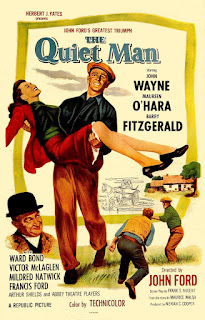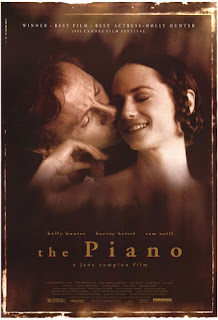May 10th: THE QUIET MAN (John Ford, 1952)
NOTE: This film will be projected in the high-definition Blu-ray format.
A retired boxer returns to rural Ireland and his childhood home, and meets resistance when attempting to court a local woman.
Director John Ford was already an old master by the 1950s, having started in the days of silent film, helping to shape the Hollywood western genre, and participating in World War II in the photographic unit as well as making a variety of war films, with 3 Oscars for directing on his mantle. Ford had purchased the rights to a short story back in 1933 and had been trying since then to mount a production shot in his ancestral Ireland.
Though Ford's pitch was rejected by various Hollywood producers, he struck a deal with Republic Pictures, known primarily for their low-budget B-movies. He would direct a cheap western with stars John Wayne and Maureen O'Hara (Miracle on 34th St, The Parent Trap) in exchange for the studio bankrolling his passion project. Ford shot Rio Grande in just over a month and moved on to his main focus.
Ford preferred working with the same people regularly, and retuning were screenwriter Frank S. Nugent, producer Merian C. Cooper, and cinematographer Winton C. Hoch, and editor Jack Murray. Normally using cheaper color film processes, Republic agreed to let Ford use Technicolor to best capture the Irish landscape. All the outdoor scenes were shot in Galway and Mayo counties, with the indoor material done back in Hollywood at the studio.
In addition to Wayne and O'Hara, Ford enlisted actors from his well-worn stock company, including Ward Bond, Victor McLaglen, Barry Fitzgerald, Mildred Natwick, Arthur Shields, and his brother Francis Ford. Two of O'Hara's own brothers were given parts, and other roles went to notable Irish stage actors.
Veteran composer Victor Young did the original score as well as implementing local folk music, with O'Hara doing her own singing on some pieces. When editing was completed, Ford was over the 2-hour limit imposed by the studio, but managed to convince executives to let the film run 9 minutes longer.
The film was a critical and commercial success, and despite being an assumed money-loser, became Ford's highest-grossing film to date. It received 7 Academy Award nominations including Best Picture, Screenplay, and Supporting Actor for McLaglen, and would win Oscars for its cinematography and for Ford's direction, his fourth setting a record that still stands.
Running time is approx. 2 hrs, 10 min.
A retired boxer returns to rural Ireland and his childhood home, and meets resistance when attempting to court a local woman.
Director John Ford was already an old master by the 1950s, having started in the days of silent film, helping to shape the Hollywood western genre, and participating in World War II in the photographic unit as well as making a variety of war films, with 3 Oscars for directing on his mantle. Ford had purchased the rights to a short story back in 1933 and had been trying since then to mount a production shot in his ancestral Ireland.
Though Ford's pitch was rejected by various Hollywood producers, he struck a deal with Republic Pictures, known primarily for their low-budget B-movies. He would direct a cheap western with stars John Wayne and Maureen O'Hara (Miracle on 34th St, The Parent Trap) in exchange for the studio bankrolling his passion project. Ford shot Rio Grande in just over a month and moved on to his main focus.
Ford preferred working with the same people regularly, and retuning were screenwriter Frank S. Nugent, producer Merian C. Cooper, and cinematographer Winton C. Hoch, and editor Jack Murray. Normally using cheaper color film processes, Republic agreed to let Ford use Technicolor to best capture the Irish landscape. All the outdoor scenes were shot in Galway and Mayo counties, with the indoor material done back in Hollywood at the studio.
In addition to Wayne and O'Hara, Ford enlisted actors from his well-worn stock company, including Ward Bond, Victor McLaglen, Barry Fitzgerald, Mildred Natwick, Arthur Shields, and his brother Francis Ford. Two of O'Hara's own brothers were given parts, and other roles went to notable Irish stage actors.
Veteran composer Victor Young did the original score as well as implementing local folk music, with O'Hara doing her own singing on some pieces. When editing was completed, Ford was over the 2-hour limit imposed by the studio, but managed to convince executives to let the film run 9 minutes longer.
The film was a critical and commercial success, and despite being an assumed money-loser, became Ford's highest-grossing film to date. It received 7 Academy Award nominations including Best Picture, Screenplay, and Supporting Actor for McLaglen, and would win Oscars for its cinematography and for Ford's direction, his fourth setting a record that still stands.
Running time is approx. 2 hrs, 10 min.










Comments
Post a Comment